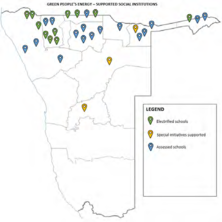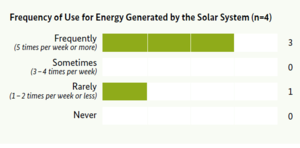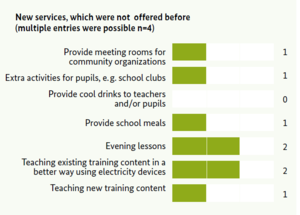Knowledge fuels change - Support energypedia!
For over 10 years, energypedia has been connecting energy experts around the world — helping them share knowledge, learn from each other, and accelerate the global energy transition.
Today, we ask for your support to keep this platform free and accessible to all.
Even a small contribution makes a big difference! If just 10–20% of our 60,000+ monthly visitors donated the equivalent of a cup of coffee — €5 — Energypedia would be fully funded for a whole year.
Is the knowledge you’ve gained through Energypedia this year worth €5 or more?
Your donation keeps the platform running, helps us create new knowledge products, and contributes directly to achieving SDG 7.
Thank you for your support, your donation, big or small, truly matters!
Electrification of Rural Primary Schools in Namibia
Electrification of Rural Primary Schools in Namibia
Project Approach
Nearly half of Namibia’s population does not have access to electricity, limiting opportunities for economic and social development. Due to the high costs of grid extension, many rural areas require decentralised solutions in order to provide electricity. As Namibia has one of the highest levels of solar radiation in the world, off-grid solar systems are an obvious way to provide clean, reliable and affordable electricity. Namibia has over 180 unelectrified schools. These schools are mainly concentrated close to Namibia’s northern borderline. Schools located in rural areas without access to electricity encounter significant challenges in providing adequate resources for both students and teachers. The absence of proper lighting impedes pupils’ ability to review their lessons during the early morning or evening, while the lack of electrical appliances such as computers and printers hinders teachers’ effectiveness in delivering their work.
With this in mind, the project aims to empower rural communities by improving the electrification of social infrastructure. Specifically, the project implements a comprehensive plan to provide electricity to a total of 15 primary and combined schools in various rural regions of Namibia. Through the Ministry of Education, Arts and Culture, Grüne Bürgerenergie (Green People’s Energy, GBE) provides some of the 15 selected schools with an insulated prefabricated container designed by MME specifically for solar installations. The containers are delivered and installed by the above-mentioned solar installation companies. The Namibia Energy Institute oversees the project implementation and ensures that each step of the implementation process is followed as agreed by the project implementation steering committee (MME, Ministry of Education, Arts and Culture, Ministry of Industrialization and Trade and Namibia Training Authority). Hence, theGBE project complements MME’s programme by installing new systems and rehabilitating and modernizing old systems. The GBE project fully funds the system installation, whereas the MME supports pre-installation planning and logistics. The containers hold various system components, including solar inverters, AC and DC distribution boards, chargers, and batteries. The solar panels themselves are securely mounted on a structure outside of the containers, including an anti-theft mechanism. A separate lockable structure provides secure access for maintenance and operational activities. Furthermore, the containerised system is mobile and can be easily relocated to other sites, for example, if the school is one day connected to a grid. Initially, 6 m x 2 m shipping containers were modified and used to accommodate lead acid batteries, which require more surface area.However, new lithium-ion batteries only need a small corner, hence the MME approved the 3 m x 3 m container installed. The largest system installed is 24 kWh, while the smallest is 8 kWh, and the average size is 13 kWh. Installing containers is generally costly, and it is also a challenge to transport a container to schools due to poor road conditions. Therefore, GBE Namibia has launched a design competition with the Department of Architecture, Planning & Construction of the Namibian University of Science and Technology. The competition aims to challenge the students to develop sustainable and cost-effective alternatives to containers using local inputs. The winning designs will be piloted. The container systems are used not only due to their practicality, but also because they match the existing container systems already implemented and maintained by the MME. To ensure that the school’s PV systems are properly maintained, school staff are being trained to carry out minor maintenance tasks. Moreover, MME has committed to supervise the installations and taking over the maintenance in collaboration with its Regional Electricity Distribution Companies.Methodology of Data Collection
Data for this case study report was collected through a project document review, six qualitative interviews with representatives of GIZ, MME, Namibia Energy Institute, Trinity Business Solutions, Ministry of Education, Arts, and Culture, and one school, and a quantitative survey of six schools that have already installed the solar system by May 2023. Four of the six schools responded to the survey. The case study was conducted between January and September 2023. At that time, some project activities were still ongoing. As a result, the impacts captured are not exhaustive.
Key Findings
Project Achievements
Fifteen installations, including solar systems, solar water heaters, and solar water pumps are scheduled to be installed in the social institutions, thirteen of which have been successfully installed at the time of writing. 2740 pupils and 130 teachers are benefiting from the systems installed. The process of installing the remaining solar systems is currently underway.In three out of the four schools which participated in the survey, the newly installed solar system replaced an old solar system, while one school received access to electricity for the first time through the solar system. Based on the survey results, most schools are using their solar energy systems to their full potential. Specifically, of the four schools surveyed, three report using their solar energy system more than five times per week, while one school uses it infrequently, between one and two times per week (see figure 2).The inclusion of solar powered systems in educational facilities is a significant step forward, with benefits for both students and teachers. With access to electricity, the schools are now able to provide classroom lighting and incorporate modern technology, such as computers, printers, mobile phone chargers, and tablets for pupils. Furthermore, some of the schools are now using electricity for other equipment, such as projectors, radios, CD players, TVs, classroom cooling, internet and school phones. Additionally, a newly equipped school hostel uses the solar water heater to provide warm water for the pupils and an installed solar water pump is in operation in a community seed bank to increase its productivity.
Intermediate Impact
The survey results show that the solar systems have a positive impact on the number of regular classroom lessons in the schools. All four schools surveyed report a significant increase in regular classroom lessons due to the provided electricity. They also state that the number of pupils increased significantly. Improving school lighting is crucial to ensure that students receive betterquality education. By ensuring that classrooms are well lit, students can focus better on their studies. Schools have also started to offer new services that were previously not possible, such as evening classes and the provision of improved educational content using electrical equipment. One school now offers school meals and extracurricular activities for pupils, such as school clubs and meeting rooms for community organisations (see figure 3).In addition, in most cases the solar systems have had a positive impact on the schools’ running energy cost. Two schools saw a reduction in energy costs, while another one saw no change but switched from a petrol generator to the more sustainable solar system. Moreover, all schools have eliminated the need for external services, such as printing and copying, and the money saved is now being used to improve other educational initiatives like paying the monthly Digital Satellite (DS) TV subscription for pupils to watch TV lessons and other educational programs. Additionally, savings can be used to purchase internet data to improve their online learning and research capabilities. This approach has a positive impact on the overall quality of education in these schools.
Finally, one interviewee pointed to other positive impacts as the electrified schools facilitate social gatherings such as cinemas, theatres, and other community meetings in the evening hours. These events are now held in the electrified school halls, providing a safe and welcoming space for the villagers to come together.
Challenges in Project Implementation
As one interviewee pointed out: The original plan was to house components of the solar energy system in one of the school rooms or in the headmaster’s office. However, after careful consideration of safety and durability issues, MME suggested using more expensive containers. Unfortunately, this decision caused delays and additional unplanned costs in the implementation process. Furthermore, teachers who work at rural unelectrified schools are eligible for a so-called “bush allowance”. To make the location more attractive to qualified teachers despite lack of energy, teachers get a financial incentive.
However, it was noted that some teachers in remote rural areas, particularly those at the Ondjabayonghalu Combined School, are in a dilemma of needing both energy and the bush allowance. When GBE supports the school with a solar system, the school is referred to as electrified. As a result, the school might be reclassified as having a lesser hardship and the bush allowance might be reduced or removed. Thus, for teachers who are used to the bush allowance it becomes a challenge. Some teachers at Ondjabayonghalu Combined School moved out from the electrified teacher housing units to non-electrified informal housing structures in order to continue to benefit from the bush allowance.
Lessons Learned
Thorough preliminary research is crucial for the successful design and implementation of school electrification projects. In particular, dimensioning the solar system depends on the size of the school and the intended use of the electricity, amongst other factors. A proactive approach to this crucial step helps to better plan the project budget and avoid over- or under-production of electricity. The aspect of energy efficiency should be taken into consideration, when supporting schools with solar systems. For example, energy efficient lights and appliances should be added to ensure sustainability of the system. Moreover, supporting schools with basic technology required for online learning should be considered because after installation of the solar system some schools are starting from scratch. For example, even though they have been electrified, the teachers travel to the nearest village or town to print as they don’t have a printer.
Sustainability of the Intervention
One of the key features of this project is the installation of a reliable solar system that uses the latest generation of solar technology. According to the survey report, the solar-powered systems of all four schools surveyed are still functioning School staff have been trained by the solar installation companies to carry out minor maintenance on a regular basis to ensure optimum performance. Pre-installation training is theoretical and aimed at educating the beneficiaries about the system to be installed, and post-installation training is practical to show the beneficiaries how the installed system works and how to troubleshoot and do basic maintenance such as cleaning the solar panels.However, it is common for teachers to be transferred to other schools, resulting in new teachers arriving without maintenance training. Regular training of school staff on maintenance is therefore necessary to avoid loss of the required skills and knowledge. Furthermore, the contracts with the solar installation companies include one-year after-sale service. During this period, they are responsible for all maintenance activities, including extensive maintenance and any repairs that are beyond the capabilities of the trained teachers. After this first year of operation, such services (also including battery replacement) have to be paid for either by the respective regional council or the MME. However, one interviewee pointed out that there are difficulties in communicating information to the solar companies. As the school has to inform the Regional Directorate of Education first, which then informs the installation company, this can cause delays in repairs, which can result in the school being without electricity for a long period of time. It is important to address this issue to ensure that the school remains fully operational and that power outages do not negatively impact the students. MME has formally includedGBE funded solar systems in its maintenance programme, therefore the key issue of long-term sustainability of the solar systems has been ensured.
Conclusion and Outlook
The project approach was appropriate, carefully designed and well implemented. All stakeholders, including the MME, the installation companies, the schools, and GBE worked together seamlessly. All four schools surveyed said they have recommended the solar technology to other schools. In fact, two of the schools surveyed report that other schools have bought a solar system based on their advice and that further schools are now interested in learning more about solar systems. This shows that the GBE project had a positive impact on the schools involved and has raised awareness of solar technology in other schools. In order for the positive results of adopting solar technology to spread further, regular awareness campaigns should be conducted to highlight the advantages and benefits of solar electricity. Hence, more schools will likely adopt solar technology in the future.
As GBE’s intervention comes to an end, further up-scaling and replication of the project’s approach will require that government institutions as well as local and international NGOs join forces to extend similar activities to other non-electrified schools. To ensure the success of this endeavour in other communities or countries, the following best-practices from the GBE project in Namibia stand out when planning and implementing such a project.
Conducting preliminary research to identify schools in need of electricity and taking into account all the necessary details for the correct sizing of the solar systems is essential to planning solar systems tailored to the schools needs. In addition, training local technicians for maintenance and involving stakeholders in the process of identifying the target group/community are critical steps. Lastley, school electrification projects should take a holistic approach in their planning and not only consider systems to provide solar energy for the schools but also include the provision of devices needed to support the lectures (e. g. printers and computers), internet access, as well as address the shortage of classrooms to improve the quality of education. Taking these necessary steps can contribute to the successful replication of the project approach, benefiting further schools and communities in need.
























